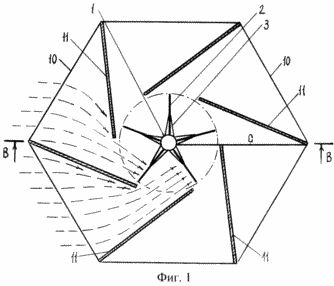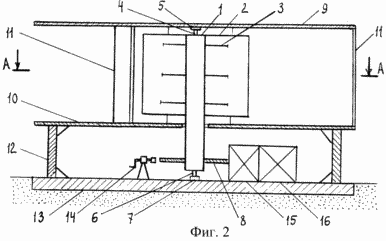| Start of section
Production, amateur Radio amateurs Aircraft model, rocket-model Useful, entertaining |
Stealth Master
Electronics Physics Technologies Inventions |
Secrets of the cosmos
Secrets of the Earth Secrets of the Ocean Tricks Map of section |
|
| Use of the site materials is allowed subject to the link (for websites - hyperlinks) | |||
Navigation: => |
Home / Patent catalog / Catalog section / Back / |
|
INVENTION
Patent of the Russian Federation RU2237822
![]()
Wind turbine for wind turbine
The name of the inventor: Seleznev Nikolai Vasilievich
The name of the patent holder: Seleznev Nikolai Vasilievich
Address for correspondence: 123317, Moscow, 1-st Krasnogvardeiskiy pr-d, 20, ap. 43, N.V. Seleznev
Date of commencement of the patent: 2003.02.20
The invention relates to wind energy and can be used in the construction of power plants. The technical result is to increase the efficiency of the windmill. The windmill contains a vertical shaft with flat blades attached to it. The shaft through the gear wheel and gearbox is mechanically connected to the electric generator. Around the blades between the upper and lower plates are installed wind control walls, some of which are located near the circumference, describing the blades, and their other ends are withdrawn to the periphery. The opposite ends of adjacent walls are arranged along a straight line passing through a vertical shaft.
DESCRIPTION OF THE INVENTION
The invention relates to wind energy and can be used for the construction of wind power plants.
Various wind turbines with flat blades are known. The most perfect of them is a wind turbine, which contains a vertical shaft with rotary blades, which is connected to the bottom with an electric generator (patent of the Russian Federation No. 2029885, 1995 - prototype).
The main drawback of this engine is that its blades take on the strength of the wind, acting only within their dimensions, which does not allow to develop a large power generator.
The object of the invention is to increase the efficiency of the windmill. This problem is solved by the fact that wind blades are installed around the blades between the upper and lower plates, some of whose ends are located at the circumference describing the blades, and their other ends are withdrawn to the periphery, the opposite ends of adjacent walls being arranged along one straight line passing through the vertical shaft .
 |
 |
The wind turbine is schematically shown in FIG. 1 - a section AA and FIG. 2 is a section BB.
The windmill contains a vertical shaft 1 and fixed flat blades 2 attached to it, further connected to the shaft 1 by struts 3. The shaft is a tube to which a rod 4 is inserted into the bearing 5 and a rod 6 is supported from below, supported by a bearing 7, and A gear wheel 8. Above the blades 2 and below there are upper and lower plates 9 and 10. A bearing 6 is attached to the upper plate 9, and the lower plate 10 has an opening for the shaft 1 to pass therethrough.
Around the blades 2 between the top and bottom plates 9 and 10 are installed wind control walls 11. Some ends of these walls are located at the circumference, describing the blades 2, at the minimum distances from it / 10-15 cm /, necessary for free rotation of the blades 2. Other ends of the walls 11 are withdrawn to the periphery. The opposite ends of the adjacent walls 11 are arranged along a straight line C passing through the shaft 1.
The lower plate 10 is fixed to the building 12 having a base plate 13 on which the thrust bearing 7, the screw brake 14, the reduction gear 15 and the power generator 16 are installed.
The vertical shaft 1 is mechanically connected through the gear wheel 6 and the reduction gear 15 to the electric generator 16.
In the building 12 there are rooms for electroaccumulators, instrumentation and spare parts, which are not shown in FIG. 2, since their arrangement is of no fundamental importance.
Wind turbine works as follows. In the direction of the wind, for example, from left to right, as shown in FIG. 1 by dashed lines, the airflow enters the tapering channels formed by the walls 11 and presses on the blades 2 located on one side of the shaft 1, not falling on the blades 2 located with The other side of the shaft 1 due to the fact that the opposite ends of the adjacent walls 11 are arranged along one straight line passing through the shaft 1. In other wind directions, the air flow enters the channels between the other walls 11 and operates in a similar manner.
As a result, the shaft 1, together with the blades 2 attached to it, receives a rotary motion which is transmitted to the generator 16 via a gear 8 and a speed reducer 15 increasing the speed of rotation.
The air flow, passing in the narrowing channels between the walls 11, is compacted and increases its speed, which increases the pressure force on the blade 2 and, accordingly, the power of the power generator 16.
If it is necessary to stop the rotation of the shaft 1, the brake 14 is pressed against the gear 8.
The energy generated by the generator 16 is transferred to its consumers and partly to the electroaccumulators that are used during periods of calm.
This wind turbine is much more efficient than the prototype, because in it wind energy is used from the vertical area of its entrance into the channel formed by the walls 11, which is several times larger than the area of the blade 2. The longer the walls 11, the more wind is captured by them and the more energy is generated by the electric generator 16.
CLAIM
A windmill comprising a vertical shaft with fixed flat blades attached to it, mechanically coupled through a gear and a gearbox with an electric generator, characterized in that wind blades are installed between the blades between the upper and lower plates, some of whose ends are located at the circumference of the blades, and their other The ends are withdrawn to the periphery, the opposite ends of the adjacent walls being arranged along a straight line passing through the vertical shaft.
print version
Publication date 31.01.2007gg




Comments
Commenting on, remember that the content and tone of your message can hurt the feelings of real people, show respect and tolerance to your interlocutors even if you do not share their opinion, your behavior in the conditions of freedom of expression and anonymity provided by the Internet, changes Not only virtual, but also the real world. All comments are hidden from the index, spam is controlled.